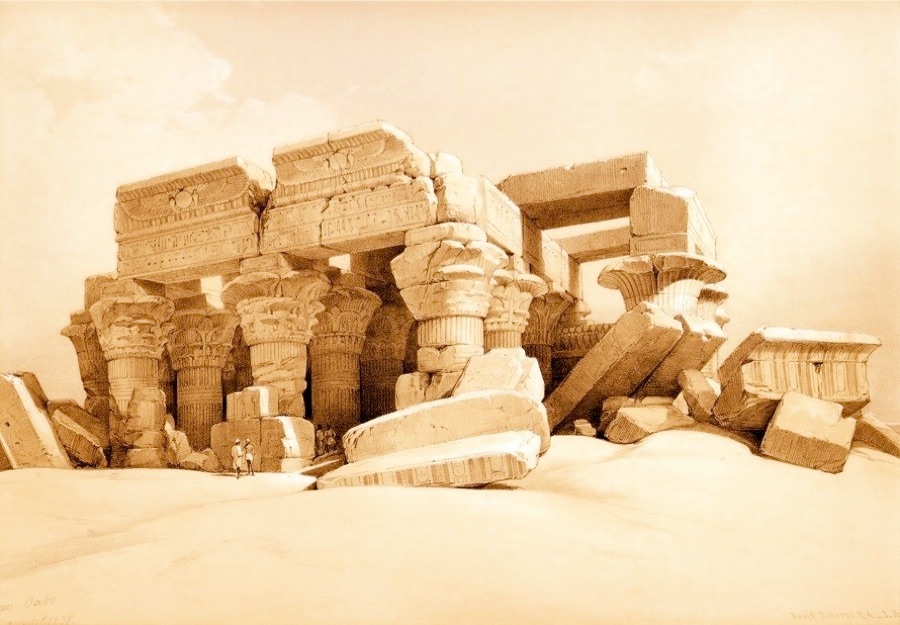RUINS OF THE TEMPLE OF KOM-OMBO, UPPER EGYPT.
THESE ruins are finely situated on a promontory on the eastern side of the river, in a bay formed by a bend of the Nile to the westward. In descending the river, the Temple thus seen on the high bank above it holds a striking position. There are remains of other Temples below, on the verge of the Nile, but the stream which sweeps round the bend has already carrried off, even within our own time, some of these interesting monuments, and will eventually remove them all by undermining the banks. Of the great Temple, much is concealed by vast sand-drifts from the deserts; but enormous masses of its ruins rise above the arid and herbless surface which surrounds them, giving to the scene a character of dreary desolation in keeping with the decay of this once magnificent structure.
The façade fronts the west, an exception to the general aspect of the Temples on the Nile, which almost invariably face the east; it is also one of the very few on the eastern bank of the river. The Temple is remakable for a dual character, “a peculiarity,” says Wathen, “illustrated by an inscription. A column instead of an interspace occupied the centre of the portico, and two lateral entrances led to a double suite of inner doorways; the inscription explains that the Temple was dedicated to two divinities, the great god, Aroeris Apollo, and the tutelary deity of Ombos.” Its façade of five columns is eighty-three feet wide, and the whole depth of the building about one hundred and twenty feet. Over the door, on either side of the centre column, on the cornice of the enormous blocks which form the entablature, are the winged globe and serpents, and on the frieze a double line of large hieroglyphics. The vast size of the stones of this Temple has struck every traveller; “some of the slabs,” says Wathen, “of which the flat ceilings were composed, are twenty-seven feet long,” nearly seven feet wide, and five feet thick. As these masses lie about in utter confusion, they suggest the queries, By what power were they transported hither - erected - and have displaced? In their erection a singular order of inversion prevails: the largest blocks have been employed in the superstructure. Every exposed spot on column or cornice is covered with hieroglyphics, and the Temple once bore on its surface the records of its own history. The cartouche of Tothmes III. is found inscribed here, 1600 B.C.; yet some of the learned in Egyptian antiquities would reduce its age to the Ptolemaic period, 1500 years later, misled probably by additions then made to the Temple. The figure of Savak, the deity of Ombos, who is represented with the head of a crocodile, marks that this bestial worship was once held here, and the animal is frequently found represented in the hieroglyphics of the Temple. Even as late as the time of Domitian, the inhabitants of Ombos, who worshipped the crocodile, fought a desperate battle in honour of their god with the people of Dendera, who worshipped the snake. Juvenal, who at that period was in Egypt, relates, in the fifteenth Satire, that the latter were merciless victors.
“On ascending to the esplanade of the upper temple, I was more than ever,” says Mr. Roberts, “ struck with its beauty. I viewed it on all sides, and each seemed more beautiful than the other. The portico originally consisted of fifteen pillars; thirteen only are standing. Those at the angles of the façade have fallen; their capitals, like those of Apollinopolis, are varied with the lotus and the palm. Here, as in other temples, attempts at destruction by fire are evident, and so fresh, that the colour of its effects on the stones is as clear as if it had only happened yesterday. The sanctuaries, for there are two formed out of one chamber by a partition, are so filled with sand as to be almost inaccessible. An immense wall of sunburnt bricks appears to have inclosed the precincts of the Temple, and a few houses peeping above the sand is all that can be now seen of the once proud Ombos. Like its rival, Dendera, it is now desolate.”
Wathen’s Arts and Antiquities of Egypt. Wilkinson’s Egypt and Thebes. Dr. Richardson’s Travels. Roberts’s Journal.


